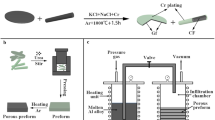Abstract
The main objective of this work was to prepare nanocomposites based on novolac resin/short carbon fibers having appropriate mechanical properties and the ideal thermal and ablative properties. In order to evaluate the thermal and ablative properties a composite consisting of 40 wt% carbon fiber was prepared as reference sample which its matrix was modified with three types of reinforcements, including micron-sized kaolinite, nano-sized kaolinite and graphite powders. Filler concentrations in the kaolinite nanocomposites and graphite nanocomposites were 6, 9 and 12 wt% and in the micron-sized kaolinite filled composite was 20 wt%. The investigation and measurement of thermal properties were made by TGA, hot plate and oxyacetylene flame tests. The three-point bending test was performed to measure the mechanical properties of the samples. The obtained results showed that the addition of micron-sized kaolinite although led to an increase in the thermal properties but impaired the mechanical properties dramatically. Substitution of micron-sized particles by nanometer-sized particles improved thermal properties and also prevented the severe reduction of mechanical properties, and thus, maintained them in an ideal state. Addition of 9 wt% nanographite particles increased thermal stability by 12 % compared to the reference sample. Moreover, in nanocomposite with 9 wt% graphite, the rate of ablation and thermal diffusivity coefficient decreased by 10 and 62 %, respectively.









Similar content being viewed by others
References
Rasky DJ, Tran HK (1999) Low-cost entry system for future planetary exploration missions. Acta Astronaut 45:347–355
Kline GM (1959) Behavior of reinforced plastics at very high temperatures-part 2. Mod Plast 21:137–139
Resch CL (1992) Ablation models of thermal protection materials. Johns Hopkins APL Techn Degest 13:3
Torre L, Kenny JM, Maffezzoli AM (1998) Degradation behavior of a composite material for thermal protection systems, part II process simulation. J Mater Sci 33:3145–3149
Torre L, Kenny JM, Maffezzoli AM (1998) Degradation behavior of a composite material for thermal protection systems, part I experimental characterization. J Mater Sci 33:3143–3177
Torre L, Kenny JM (2000) Degradation behavior of a composite material for thermal protection systems, part III char characterization. J Mater Sci 35:4563–4565
Gibson AC, Hume J (1995) Fire performance of composite panels for large marine structures. Plast Rub Compos Process Appl 23:175–183
Hiltz AA, Florence DE, Lowe DL (1968) Thermal protection systems for a mars-entry vehicle. J Spacecr 5:11
Kanevce LD, Kanevece GH (1999) Comparison of two kinds of experiments for estimation of thermal properties of ablative composite. In: 3rd international conference on inverse problems in engineering, Port Ludlow, WA, USA
Bahramian AR, Kokabi M, Famili MHN, Beheshty MH (2006) Ablation and thermal degradation behaviour of a composite based on resole type phenolic resin; process modeling and experimental. Polymer 47:3661–3673
Lachaud J, Martin A, Cozmuta L, Laub B (2011) Ablation workshop test case-version 1.1-Feb 2011. In: 4th Ablation workshop, Albuquerque, New Mexico
Bahramian AR, Kokabi M, Famili MHN, Beheshty MH (2007) Thermal degradation process of resole type phenolic resin kaolinite layered silicate nanocomposite. Iran Polym J 16:375–387
Koo JH, Natali M, Tate J, Allcorn E (2013) Polymer nanocomposites as ablative materials—a comprehensive review. Int J Energ Mater Chem Propul 12(2):119–162
Bahramian AR (2013) Effect of external heat flux on the thermal diffusivity and ablation performance of carbon fiber reinforced novolac resin composite. Iran Polym J 22:579–589
Razzaghi Kashani M, Behazin E, Fakhar A (2011) Construction and evaluation of a new tribometer for polymers. Polym Test 30(3):271–276
Bahramian AR, Kokabi M (2009) Ablation mechanism of polymer layered silicate nanocomposite heat shield. J Hazard Mater 166:445–454
Acknowledgments
The authors would like to thank Tarbiat Modares University and Iran Nanotechnology Initiative Council (INIC) for supporting this research work.
Author information
Authors and Affiliations
Corresponding author
Rights and permissions
About this article
Cite this article
Bahramian, A.R., Astaneh, R.A. Improvement of ablation and heat shielding performance of carbon fiber reinforced composite using graphite and kaolinite nanopowders. Iran Polym J 23, 979–985 (2014). https://doi.org/10.1007/s13726-014-0293-0
Received:
Accepted:
Published:
Issue Date:
DOI: https://doi.org/10.1007/s13726-014-0293-0




